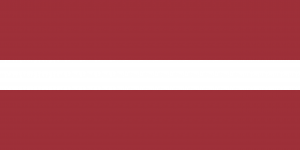Difference between revisions of "Language/Standard-latvian/Culture/Latvian-folklore-and-crafts"
m (Quick edit) |
m (Quick edit) |
||
| Line 1: | Line 1: | ||
<span pgnav> | |||
{| class="wikitable pg_template_nav" | |||
|[[Language/Standard-latvian/Culture/Latvian-cuisine|◀️ Latvian cuisine — Previous Lesson]] | |||
|[[Language/Standard-latvian/Grammar/Latvian-verb-conjugation-in-the-present-tense|Next Lesson — Latvian verb conjugation in the present tense ▶️]] | |||
|} | |||
</span> | |||
{{Standard-latvian-Page-Top}} | {{Standard-latvian-Page-Top}} | ||
| Line 90: | Line 97: | ||
{{Standard-latvian-Page-Bottom}} | {{Standard-latvian-Page-Bottom}} | ||
<span links></span> | <span links></span> | ||
<span pgnav> | |||
{| class="wikitable pg_template_nav" | |||
|[[Language/Standard-latvian/Culture/Latvian-cuisine|◀️ Latvian cuisine — Previous Lesson]] | |||
|[[Language/Standard-latvian/Grammar/Latvian-verb-conjugation-in-the-present-tense|Next Lesson — Latvian verb conjugation in the present tense ▶️]] | |||
|} | |||
</span> | |||
Revision as of 19:12, 29 March 2023
| ◀️ Latvian cuisine — Previous Lesson | Next Lesson — Latvian verb conjugation in the present tense ▶️ |
Latvians have a long and rich tradition of folklore and crafts, which reflect the country's rural roots, strong sense of community, and love for nature. In this lesson, we will explore the main features of Latvian folk culture, including songs, dances, costumes, and handicrafts, and learn how they have evolved over time and have become part of Latvia's national identity.
With the completion of this lesson, consider investigating these related pages: Latvian museums and exhibitions & Latvian art and architecture.
Latvian folk traditions
Latvian folk traditions comprise a wide variety of folk songs, dances, and games, which were passed down from generation to generation and were an integral part of rural life until the 20th century. Today, these traditions are celebrated all over Latvia and are an important source of national pride and cultural heritage.
Folk songs
Latvian folk songs or "dainas" are short, rhymed verses that were traditionally sung solo or in groups at various occasions such as weddings, funerals, and harvest festivals. They usually contain themes of love, nature, work, and faith, and reflect the emotional and spiritual life of Latvian peasants.
Here are some examples of Latvian folk songs:
| Standard Latvian | Pronunciation | English Translation |
|---|---|---|
| Ligo, ligo, lemanīti | ['liɡɔ 'liɡɔ lɛma'niːti] | Sing, sing, dear little bird |
| Jūras baltā jūras dziesma | ['juːras 'baltɑ 'juːrɑs 'dziɛsma] | The white sea's song of the sea |
| Dziedi, zeme, mūsu kara vīri | ['dziɛdi 'zɛmɛ 'muːsu 'karɑ 'viːri] | Sing, earth, of our warriors at war |
Folk dances
Latvian folk dances or "dejas" are group dances that were traditionally performed by couples or in larger circles at various festive occasions. They usually involve intricate footwork, lively music, and colorful costumes, and reflect the joy, harmony, and unity of the Latvian community.
Here are some examples of Latvian folk dances:
- "Laima rakstīja tekstu" (Laima wrote the text) - a traditional circle dance where dancers move in pairs and perform various turning and spinning steps while holding hands.
- "Leģendas" (Legends) - a more recent dance that combines elements of Latvian folk dance and modern choreography and narrates the story of a young couple's love and separation.
Folk costumes
Latvian folk costumes or "tērpi" are traditional garments that were worn by Latvian peasants and farmers until the 20th century. They usually comprise several layers of clothing, such as linen shirts, woolen skirts, woolen socks, and leather boots, and are decorated with intricate patterns, embroidery, and accessories.
Here are some examples of Latvian folk costumes:
| Image | Description |
|---|---|
| File:Latvian dancer 1.jpg | A Latvian folk dancer wearing a long white linen shirt, a colorful woolen skirt, and embroidered belt and apron, woolen socks, and leather boots. |
| File:Latvian bride 1.jpg | A Latvian bride wearing a long white linen shirt, a red woolen skirt, a bright red sash, and a flower wreath on her head. |
Latvian handicrafts
Latvian handicrafts or "amatniecība" are traditional crafts that involve the use of various natural materials such as wool, linen, wood, and clay, and reflect the practical and artistic skills of Latvian craftsmen and artisans. They usually range from pottery, weaving, and embroidery to woodworking, metalworking, and jewelry making, and are passed down from generation to generation through family workshops and apprenticeships.
Here are some examples of Latvian handicrafts:
- Pottery - Latvian pottery or "keramika" is a traditional craft that involves shaping and firing clay into various objects such as bowls, plates, and vases. Latvian potters usually use simple shapes, natural colors, and geometric decorations inspired by Latvian folklore and nature.
- Weaving - Latvian weaving or "audekls" is a traditional craft that involves using a loom to produce various textiles such as blankets, rugs, and clothes. Latvian weavers usually use wool, linen, or hemp fibers and weave intricate patterns, stripes, and checks inspired by Latvian folklore and nature.
- Amber jewelry - Amber jewelry or "dzintars" is a traditional craft that involves carving, polishing, and stringing Baltic amber into various objects such as necklaces, bracelets, and earrings. Latvian amber craftsmen usually use amber of different colors, shapes, and textures and create various patterns and motifs inspired by Latvian folklore and nature.
Conclusion
In this lesson, we have explored the rich and diverse world of Latvian folk culture, including folk songs, dances, costumes, and handicrafts. We have learned how these traditions have evolved over time and have become an integral part of Latvia's national identity and cultural heritage. By studying Latvian folklore and crafts, we can deepen our understanding of Latvian history, society, and values, and appreciate the beauty and creativity of Latvian arts and traditions.
Other Lessons
- Popular sports and events
- Major historical events and figures
- Latvian holidays and celebrations
- Latvian cuisine
- Latvian nature and national parks
- Latvian cities and regions
- Latvian language and literature
- Latvian music and dance traditions
- Latvia Timeline
| ◀️ Latvian cuisine — Previous Lesson | Next Lesson — Latvian verb conjugation in the present tense ▶️ |
